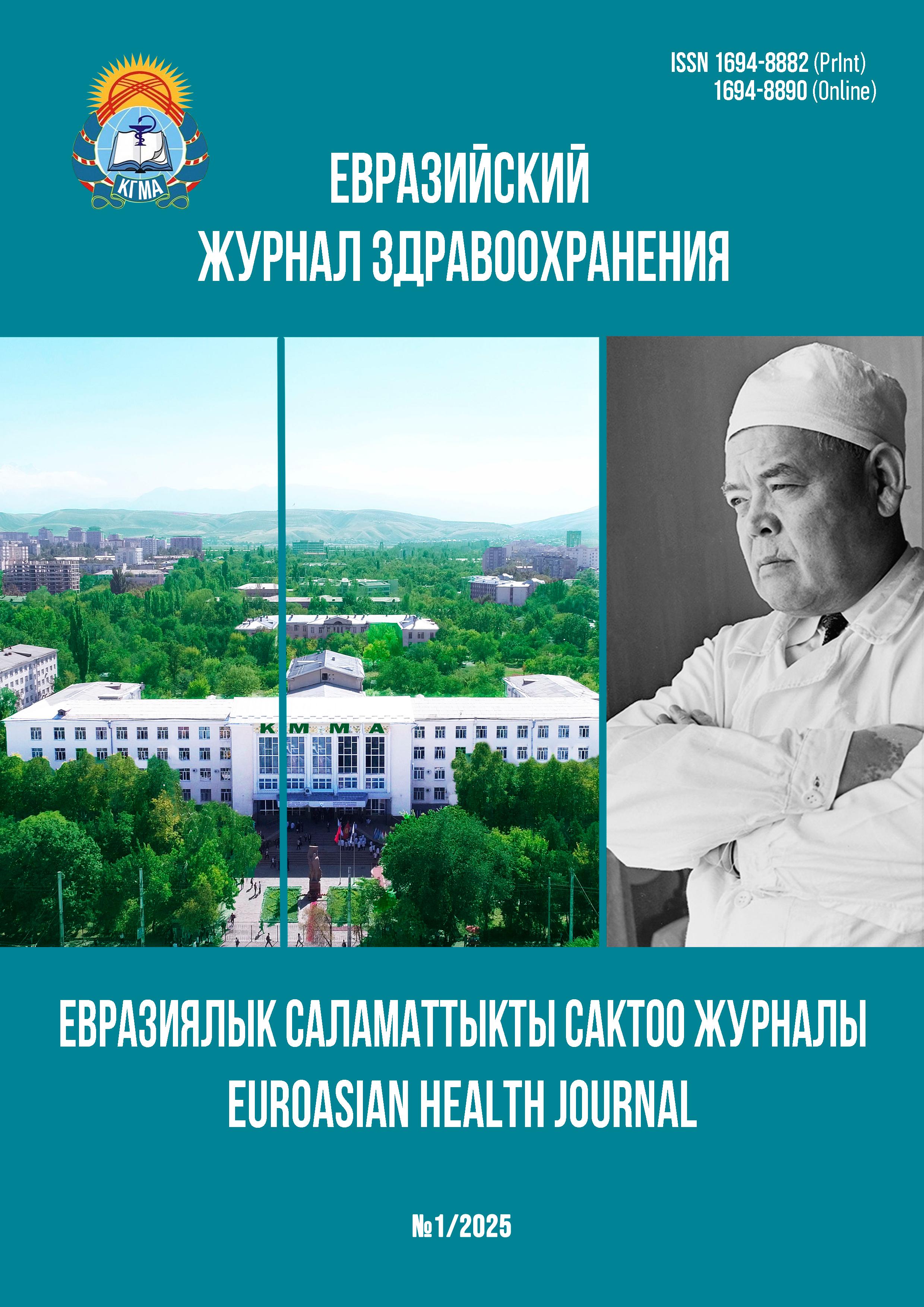COMPARATIVE CHARACTERISTICS OF THE DAILY FOOD PACKAGE FOR SCHOOLCHILDREN IN KYRGYZSTAN
DOI:
https://doi.org/10.54890/1694-8882-2025-1-245Abstract
Nutrition is a key factor in the health and well-being of children, affecting their growth and development. In modern conditions, many children face a deficiency of nutrients, which negatively affects their health. Objective: to provide a hygienic characteristic of the daily food set of school-age children and adolescents living in different regions of the Kyrgyz Republic.
Materials and methods. A study of the daily food set of 4877 schoolchildren aged 7 to 17 years living in different regions of the republic was conducted using hygienic, epidemiological and statistical methods.
Results. Data on food consumption by schoolchildren in different regions of the Kyrgyz Republic show that the consumption of animal products is significantly lower than the recommended norms, with pronounced regional differences. In particular, 52.3% of schoolchildren in the south and 50.4% of the northern regions have a deficiency in meat consumption, and 59.0% of children in the northern regions experience a deficiency of dairy products. In the food sets of schoolchildren, grain products accounted for 38.4% of the total diet. Gender differences in the consumption of the main food groups were established.
Conclusions. Analysis of the daily diet of schoolchildren revealed insufficient consumption of biologically valuable products, which indicates a quantitatively and qualitatively unbalanced diet.
Keywords:
children and adolescents, schoolchildren, food set, main food groups, consumption volume, regions of the republicReferences
1. Esdaile EK, Wharton L, Vidgen H, Gallegos D. Teacher perspectives on the socio-ecological barriers and enablers to food and nutrition education in primary schools: a scoping riview. Public Health Nutrition. 2024;27(1):e175. https://doi.org/ 10.1017/S1368980024001812
2. Kyere P, Veerman JL, Lee P, Stewart DE. Effectiveness of school-based nutrition interventions in sub-Saharan Africa: a systematic review. Public Health Nutr. 2020;23 (14):2626-2636. https://doi.org/10.1017/S1368980020000506
3. World Health Organization. Implementing school food nutrition policies: a review of contextual factors. World Health Organization: Geneva, Switzerland; 2021. 98 p. Available from: https://www.who.int/publications/i/item/9789240035072
4. Al-Jawaldeh A, Matbouli D, Diab S, Taktouk M, Hojeij L, Naalbandian S, et al. School-Based Nutrition Programs in the Eastern Mediterranean Region: A Systematic Review. Int J Environ Res Public Health. 2023;20(22):7047. https://doi.org/ 10.3390/ijerph20227047
5. Истомин А.В., Сааркоппель Л.М. Современные гигиенические проблемы фактического питания населения. Здоровье и окружающая среда: Сб. мат. международной научно-практической конференции. Минск; 2021:275-277.
6. Кучма В.Р. Медико-профилактические основы достижения ожидаемых результатов мероприятий десятилетия детства на период до 2027 года. Вопросы школьной и университетской медицины и здоровья. 2021;1:11-23.
7. Гришанова О.С. Социально-психологические аспекты оценки школьного питания субъектами системы образования. Общество: социология, психология, педагогика. 2022;7(99):95-99. https://doi.org/10.24158/spp.2022.7.13
8. Зайцева Н.В., Лир Д.Н. Мониторинг питания в общеобразовательных организациях. Вопросы питания. 2022:5(543):56-64. https://doi.org/10.33029/0042-8833-2022-91-5-56-64
9. Цукарева Екатерина Александровна, Авчинников А.В., Сидоренкова Л.М., Авчинникова С.О., Корякина Ю.П. Гигиеническая оценка организации питания в общеобразовательных учреждениях г. Смоленска. Здоровье населения и среда обитания. 2020:8(329):15-19.
10. Кучма В.Р., Рапопорт И.К. Физическое развитие и состояние здоровья детей и подростков в школьном онтогенезе (лонгитудинальное исследование): монография. М.: Научная книга; 2021. 350 с.
11. Кучма В.Р., Степанова М.И. Гигиенические требования к современным архитектурно-планировочным решениям школьных зданий. Гигиена и санитария. 2021:100(9):998-1003. https://doi.org/10.47470/0016-9900-2021-100-9-998-1003
12. Norris SA, Frongillo EA, Black MM, Dong Y, Fall C, Lampl M, et al. Nutrition in adolescent growth and development. Lancet. 2022;399(10320):172-184. https:// doi.org/10.1016/S0140-6736(21)01590-7
13. Hargreaves D, Mates E, Menon P, Alderman H, Devakumar D, Fawzi W, et al. Strategies and interventions for healthy adolescent growth, nutrition, and development. Lancet. 2022;399(10320):198-210. https://doi.org/10.1016/S0140-6736(21)01593-2
14. Мартинчик А.Н., Батурин А.К., Кешабянц Э.Э., Фатьянова Л.Н., Семенова Я.А., Базарова Л.Б. и др. Анализ фактического питания детей и подростков России в возрасте от 3 до 19 лет. Вопросы питания. 2017:86 (4):50-60. https://doi.org/10.24411/0042-8833-2017-00059
15. Лебедева У.М., Баттахов П.П., Степанов К.М., Лебедева А.М., Занковский С.С., Булгакова Л.И и др. Организация питания детей и подростков на региональном уровне. Вопросы питания. 2018;87(6):48-56. https://doi.org/10.24411 /0042-8833-2018-10066
16. Новикова И.И., Шевкун И. Г., Яновская Г.В., Гавриш С.М., Сорокина А.В. Роль мониторинга качества организации питания детей школьного возраста в снижении риска заболеваний, связанных с пищевым фактором. Здоровье населения и среда обитания. 2022;2:31-36. https://doi.org/10.35627/2219-5238/ 2022-30 2-31-36
17. Эсенаманова М.К., Кочкорова Ф.А., Саржанова К.С., Давыдова Л.Н. Рекомендуемые нормы потребления пищевых веществ, энергии и пищевых продуктов для различных групп населения Кыргызской Республики: методические рекомендации. Бишкек; 2011. 78 с.
18. Swinburn BA, Kraak VI, Allender S, Atkins VJ, Baker PI, Bogard JR, et al. The global syndemic of obesity, undernutrition, and climate change: the Lancet Commission Report. Lancet. 2019;393:791–846. https://doi.org/10.1016/ S0140-6736(18)32822-8
19. Hawkes C, Fox E, Downs S, Fanzo J, Fanzo J, Neve K. Child-centered food systems: reorienting food systems towards healthy diets for children. Glob Food Sec. 2020;27:100414. https://doi.org/10.1016/j.gfs.2020.100414
20. UNICEF. The State of the World’s Children 2019. Children, Food and Nutrition: Growing Well in a Changing World. New York: UNICEF; 2019. Available from: https://www.unicef.org/reports/state-of-worlds-children-2019
21. Neufeld LM, Andrade EB, Ballonoff Suleiman A, Barker M, Beal T, Blum LS, et al. Food choice in transition: adolescent autonomy, agency, and the food environment. Lancet 2022;399(10320):185–197. https://doi.org/10.1016/S0140-6736(21)01687-1
22. Ares G, De Rosso S, Mueller C, Philippe K, Pickard A, Nicklaus S, et al. Development of food literacy in children and adolescents: implications for the design of strategies to promote healthier and more sustainable diets. Nutr Rev. 2024;82(4):536-552. https://doi.org/10.1093/nutrit/nuad072
23. Noble C, Corney M, Eves A, Kipps M, Lumbres M. Food choice and school meals: primary schoolchildren's perceptions of the healthiness of foods and the nutritional implications of food choices. International Journal of Hospitality Management. 2000;19(4):413-432. http://doi.org/10.1016/S0278-4319(00)00038-4
24. Aslam MN, Varani J. The western-style diet, calcium deficiency and chronic disease. J Nutr Food Sci. 2016;6(3):496. 8. http://doi.org/10.4172/2155-9600.1000496
25. Шарманов Т.Ш., Салханова А.Б., Датхабаева Г.К., Сравнительная характеристика фактического питания детей в возрасте 9–10 лет. Вопросы питания. 2018;87(6):28-41. http://doi.org/10.24411/0042-8833-2018-10064
26. Richonnet C, Mosser F, Favre E, Robert M, Martin F, Thiebaut I. Nutritional Quality and Degree of Processing of Children's Foods Assessment on the French Market. Nutrients. 2021;14(1):171. http://doi.org/10.3390/nu14010171
27. Боровкова М.Г., Николаева Л.А. Анализ питания детей школьного возраста. Российский вестник перинатологии и педиатрии. 2021;66(4):148-154. https://doi.org/10.21508/1027-4065-2021-66-4-148-154
28. Богомолова И.К., Емельянова О.Н., Пискунова О.Г. Анализ фактического питания детей дошкольного и младшего школьного возраста, проживающих в г. Чите. Здоровье и образование в XXI веке. 2020;22(2):19-25. http://dx.doi.org/10.26787/nydha-2686-6838-2020-22-2-19-25
29. Roe LS, Keller KL, Rolls BJ. Food Properties and Individual Characteristics Influence Children's Intake Across Multiple Days of Weighed Assessments in Childcare Programs. J Nutr. 2023;153(5):1646-1655. https://doi.org/10.1016/j.tjnut. 2023.03.025
30. Ares G, De Rosso S, Mueller C, Philippe K, Pickard A, Nicklaus S, et al. Development of food literacy in children and adolescents: implications for the design of strategies to promote healthier and more sustainable diets. Nutrition Reviews. 2024;82(4):536–552. https://doi.org/10.1093/nutrit/nuad072
31. Лир Д.Н., Перевалов А.Я. Анализ фактического домашнего питания проживающих в городе детей дошкольного и школьного возраста. Вопросы питания. 2019;88(3):69-77. https://doi.org/10.24411/0042-8833-2019-10031







